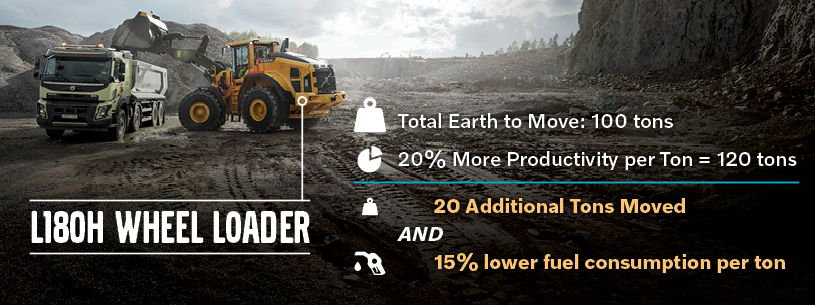After years of talking with customers about fuel efficiency, I’ve come to realize too many people have a different definition of what it really is. Many OEMs, dealers and customers alike equate fuel efficiency to fuel consumption — but there’s a difference.
Fuel consumption is how many gallons a machine burns per hour.
Fuel efficiency is how much production a machine gets per gallon of fuel, such as tons per gallon.
As the first heavy equipment OEM to emphasize fuel consumption and savings — eventually leading to our fuel efficiency guarantee — Volvo has for years focused on gallons per hour and helping customers understand that in addition to these fuel savings, you’re also getting more done for every gallon you burn. While fuel consumption is important for determining overall operating costs, it’s just one factor in calculating a machine’s overall fuel efficiency. Fuel efficiency is a reflection of efficient productivity, not simply a dollar savings.
Think about it this way: Suppose you have two similarly sized excavators. With one, you’re producing 100 tons per gallon, and it’s burning five gallons to do it. With the other, you’re producing 50 tons per gallon, and it’s burning four gallons to do it. If you look at fuel consumption data alone, you may assume the excavator with the lower burn rate is lowering your operating expenses, but you’re missing the real picture. That first machine may have higher fuel consumption, but it’s actually producing more material per gallon of fuel burned than the other. When you look at the bigger picture, the one with the higher burn rate is actually more fuel efficient — and over time, it will save you more money.
Determining Fuel Efficiency
When it comes to fuel efficiency, your goal should be to get the best ratio for tons per gallon — maximizing your tons produced while burning the lowest amount of fuel. It’s very similar to a recent Scoop post covering initial purchase price vs. total cost of ownership for used equipment. Up front, you may be tempted to purchase a machine at the lower price. But if you’re not factoring in fuel efficiency, maintenance costs, residual values and more, you’ll likely end up paying more over the life of the machine.
Factoring true fuel efficiency isn’t as difficult as it may sound either. One example we’ve experienced here at Volvo involves our H-Series 2.0 wheel loaders. They have up to 20 percent greater fuel efficiency than previous models. That means if you’re moving 100 tons of dirt on a jobsite with an L180H wheel loader, you could get up to 20 percent more tons moved per gallon while burning 15% less fuel per ton produced.

The total fuel efficiency isn’t just the gallons saved, it’s also the additional tons you moved.
Services that Promote Fuel Efficiency
At Volvo, we focus on building durable machines that maximize fuel efficiency without sacrificing performance or productivity — and we offer support programs and training opportunities that help owners maximize their bottom lines. For example, the Assist programs we offer show project and productivity data on the Volvo Co-pilot in-cab display, including fuel efficiency, so owners and operators can make on-the-fly adjustments. Operating the machine efficiently and understanding the best methods is as important as anything. That’s why we focus heavily on training our dealers who in turn train customers on the most fuel-efficient operation techniques.
Another example is the telematics data available via our ActiveCare Direct® machine monitoring program. This allows equipment owners to view fuel consumption by machine and operator to identify ways to boost productivity — and thereby fuel efficiency. Sometimes these changes can be as simple as teaching an operator to decrease idle time or operate in the proper work mode.
Volvo Site Simulation also can help customers improve fuel efficiency. It increases efficiency and profits by providing our customers with tools to reduce their total cost per ton. By analyzing worksite conditions and operational goals, we can offer advice on the proper site setup for optimum fuel efficiency and productivity. We can maximize productivity for our customers by recommending the most profitable fleet of equipment and project results based on what metrics the customer is looking to improve. This could be cost per ton or tons per gallon, or a complete total cost of ownership analysis.
See the Bigger Picture
If you’re in the market for a new machine, ask your OEM or dealer for information that goes beyond fuel consumption data alone. Converting fuel consumption numbers into a dollar amount of savings isn’t an accurate calculation of a machine’s fuel efficiency, nor does it accurately reflect what you’ve saved over a period of time. You have to look behind those numbers and include how much that machine produces for the gallons burned, then use that complete efficiency number to factor into your purchase decision.
If you’d like to learn more, visit our Volvo fuel efficiency services page.
By Blaine Pressley


